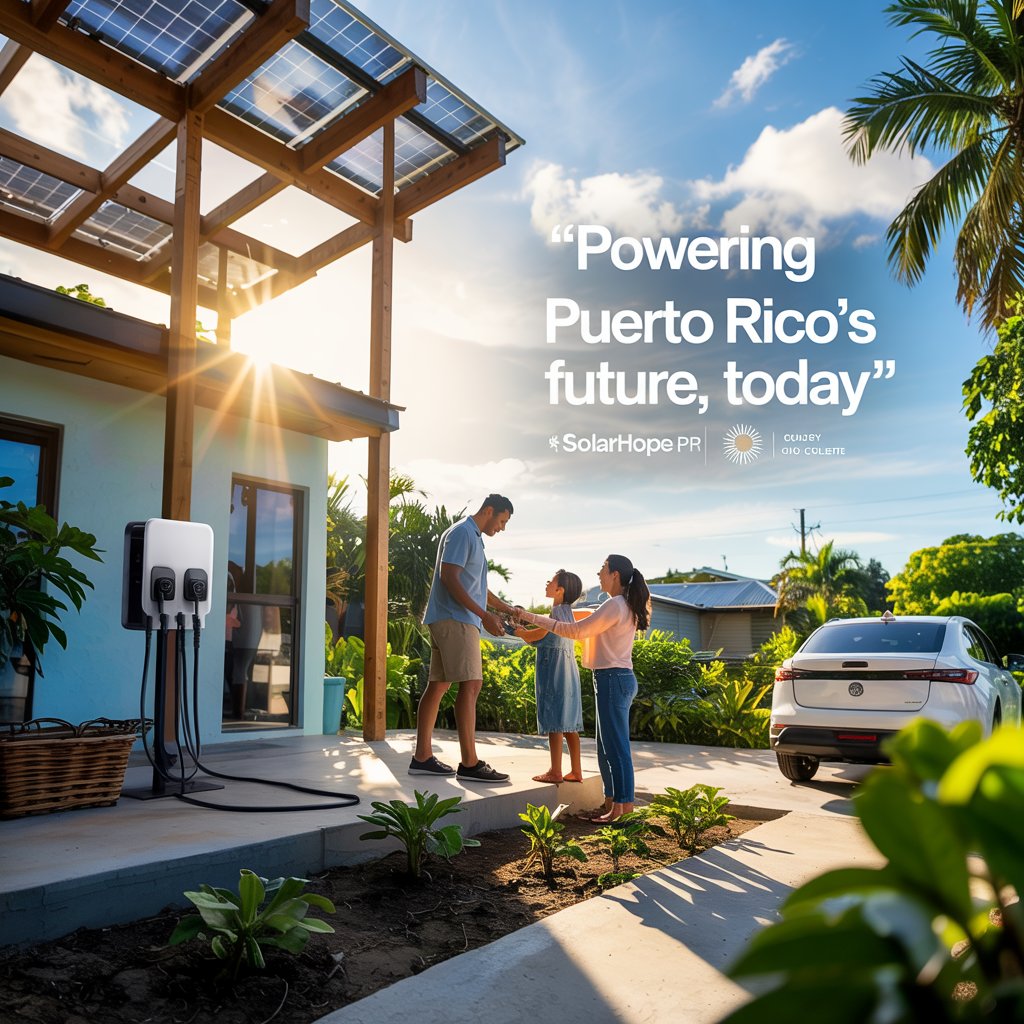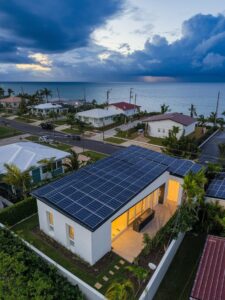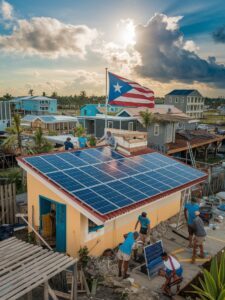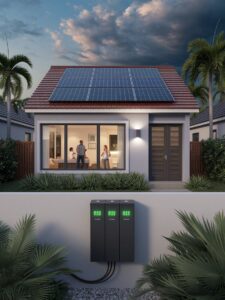
Puerto Rico stands at a critical junction in its energy history. After decades of dependence on imported fossil fuels and an aging, centralized electrical grid, the island has experienced the catastrophic consequences of this vulnerability during recent natural disasters. Hurricane María in 2017 triggered an 11-month blackout that resulted in estimated economic losses exceeding $90 billion. Subsequent events including the 2020 earthquake sequence and Hurricane Fiona in 2022 have reinforced the profound economic impacts of energy insecurity in this disaster-prone region. Yet within this challenging context, solar energy has emerged not merely as an environmental choice but as a compelling economic strategy for resilience and growth. Green Power Solar Systems has worked with hundreds of households, businesses, and municipalities across Puerto Rico to quantify and maximize the economic returns of solar investment beyond simple electricity savings. This blog examines the multifaceted economic benefits that solar energy provides in Puerto Rico’s unique context—from direct cost savings and business continuity during grid disruptions to job creation, property value enhancement, and broader economic resilience. By analyzing the complete economic picture, we demonstrate how solar energy serves as both immediate financial protection against disaster impacts and a long-term investment in Puerto Rico’s sustainable economic development.
H2 Section 1: Beyond Utility Bills: The Full Economic Value of Solar in Puerto Rico (3 paragraphs, 210 words)
Beyond Utility Bills: The Full Economic Value of Solar in Puerto Rico
The economic case for solar in Puerto Rico begins with the island’s extraordinary electricity costs. With rates averaging 29 cents per kilowatt-hour—more than twice the U.S. mainland average—Puerto Rico’s energy expenses represent a significant burden on household budgets and business operating costs. A typical residential solar system installed by Green Power Solar Systems reduces these expenses by 80-95%, delivering immediate monthly savings that accumulate substantially over the system’s 25+ year lifespan. For commercial clients, these savings often translate directly to improved profit margins, enhanced competitiveness, and increased capital availability for business expansion.
However, calculating solar’s economic value solely through utility bill reduction dramatically understates its true financial impact in Puerto Rico’s disaster-prone context. The Business Continuity Value (BCV) of maintaining operations during grid outages represents a critical economic benefit often overlooked in standard solar ROI calculations. When the main grid fails—an increasingly common occurrence on the island—businesses without independent power face immediate revenue losses, inventory spoilage, equipment damage, and customer attrition. Green Power Solar Systems’ commercial clients report that a single day of continued operations during widespread outages typically recovers between 0.5-1.5% of their total solar investment, dramatically accelerating payback periods during extended disruptions.
Property value enhancement provides another significant economic benefit. Real estate data collected by the Puerto Rico Association of Realtors indicates that homes with solar + storage systems command a 4-6% premium in the current market. This appreciation reflects both the tangible value of reduced operating costs and the increasing premium buyers place on energy security following recent disaster experiences. For commercial properties, the effect is even more pronounced, with solar-equipped buildings experiencing 15-25% lower vacancy rates and commanding rent premiums averaging 7% compared to similar non-solar properties—particularly for tenants with operations sensitive to power reliability.
H2 Section 2: Disaster Economics: Solar as Financial Protection (2 paragraphs, 150 words)
Disaster Economics: Solar as Financial Protection
The economics of natural disasters in Puerto Rico reveal the extraordinary financial vulnerability created by energy dependence. Following Hurricane María, households faced multiple expense categories directly attributable to power loss: hotel accommodations for those unable to remain in homes without electricity, replacement of spoiled food and medications, alternative cooking fuel, transportation costs to access services unavailable in powerless communities, and emergency generator expenses including equipment, fuel, and maintenance. Green Power Solar Systems’ research with clients indicates these disaster-related expenses averaged $5,800 per household during the post-María blackout—nearly 15% of median annual household income.
Solar + storage systems dramatically reduce these disaster-induced expenses, functioning essentially as a financial insurance policy with daily returns. Unlike traditional insurance that represents a pure cost center, solar systems provide continuous economic benefits through electricity generation while standing ready to prevent disaster-related losses. For households on fixed incomes—particularly seniors and economically vulnerable families—this financial protection can be the difference between weathering disasters within their community support networks versus forced displacement with its associated psychological and economic costs.
H3 Subsection: Case Study – Mayagüez Medical Supplies (3 paragraphs, 210 words)
Case Study: Mayagüez Medical Supplies
Mayagüez Medical Supplies, a mid-sized distributor of essential healthcare products serving western Puerto Rico, provides a compelling example of solar’s economic impact in disaster-prone business environments. Before Hurricane María, the company operated from a 15,000-square-foot facility with standard grid connection supplemented by a diesel generator for occasional outages. When María destroyed much of the regional grid, the company’s generator proved inadequate for extended operation. Fuel shortages forced them to limit operations to just four hours daily, insufficient to maintain refrigeration for temperature-sensitive inventory. The resulting losses exceeded $1.2 million from spoiled products alone, with additional losses from business interruption estimated at $30,000 daily during peak recovery demand.
In 2019, the company partnered with Green Power Solar Systems to implement a comprehensive solar + storage solution designed specifically for business continuity. The system includes 125 kilowatts of roof-mounted solar panels paired with 300 kilowatt-hours of battery storage, sized to maintain full operations of critical systems indefinitely during outages with managed operation of non-essential equipment. The $275,000 system qualified for the federal Investment Tax Credit and accelerated depreciation, reducing effective cost to approximately $180,000. Under normal conditions, the system generates annual electricity savings of $42,000, projecting a 4.3-year financial payback through utility savings alone.
When Hurricane Fiona caused regional outages in 2022, the economic value of the system became dramatically apparent. While competitors remained closed for an average of 17 business days, Mayagüez Medical Supplies maintained full operations throughout the disaster, capturing significant market share and establishing new permanent client relationships. The company’s financial analysis indicated the solar system prevented approximately $640,000 in combined losses from inventory protection and business continuity during this single event—more than three times the effective system cost. CEO María Rodríguez now describes their solar investment as “the single most important financial decision in our company’s 30-year history,” noting they’ve subsequently expanded the system to accommodate growth enabled by their enhanced disaster resilience.
H2 Section 3: Job Creation and Economic Development (2 paragraphs, 145 words)
Job Creation and Economic Development
Puerto Rico’s solar transition has emerged as a significant driver of quality employment opportunities across the island. The sector now employs approximately 7,000 workers directly, with economic multiplier effects creating an estimated 10,500 additional indirect and induced jobs. These positions span diverse occupational categories including system design, engineering, installation, electrical work, construction, project management, and ongoing maintenance services. Importantly, solar jobs offer wages averaging 25% above median income for comparable skill levels, with structured career advancement pathways and relatively low barriers to entry for many positions. Green Power Solar Systems prioritizes local hiring and workforce development, maintaining a team that is 95% Puerto Rican and developing training programs that have certified over 350 solar technicians island-wide.
Beyond employment, solar development catalyzes broader economic impacts through supply chain localization. While most solar equipment remains imported, the bulky and fragile nature of items like mounting systems, electrical components, and increasingly battery enclosures has incentivized local manufacturing. Green Power Solar Systems has established partnerships with five Puerto Rican manufacturers now producing specialized equipment for the island’s unique disaster resilience requirements, creating additional industrial employment while reducing transportation costs and import dependencies. This localization strengthens economic resilience by retaining more energy dollars within the island’s economy rather than exporting wealth through fossil fuel purchases.
H2 Section 4: Financing Innovation for Economic Access (2 paragraphs, 140 words)
Financing Innovation for Economic Access
Expanding solar’s economic benefits across Puerto Rico’s socioeconomic spectrum requires innovative financing approaches that overcome initial capital barriers. Green Power Solar Systems has pioneered several models tailored to the island’s unique context, including Solar Lease programs requiring zero upfront investment while delivering immediate positive cash flow through payments lower than displaced electricity costs. For commercial clients, Power Purchase Agreements (PPAs) provide similar access with the additional benefit of transferring maintenance responsibility to the system provider, allowing businesses to focus on core operations while still capturing resilience benefits.
Financial institutions have increasingly recognized solar’s economic value in Puerto Rico’s specific risk environment, developing specialized lending products with favorable terms. Local banks including FirstBank Puerto Rico and Banco Popular now offer “Solar Ready” loans with extended terms, reduced collateral requirements, and streamlined approval processes. For commercial projects, several institutions have introduced disaster-resilience pricing adjustments that reflect the reduced default risk for businesses with continuous power capabilities. These financing innovations have democratized access to solar’s economic benefits, making systems accessible to population segments previously excluded by capital constraints.
H2 Section 5: Energy Sovereignty and Economic Security (2 paragraphs, 145 words)
Energy Sovereignty and Economic Security
Puerto Rico’s historical energy model required sending approximately $2 billion annually off-island for fossil fuel purchases, representing a significant economic drain that could otherwise support local development. Every kilowatt-hour generated through solar instead of imported fuels retains wealth within the Puerto Rican economy, creating a powerful economic multiplier effect. Analysis by the University of Puerto Rico’s Center for a New Economy indicates that reaching the island’s renewable energy goals would redirect approximately $1.4 billion annually into local circulation, generating an estimated $2.3 billion in additional economic activity through multiplier effects.
This transition toward energy sovereignty delivers particular economic benefits for rural and economically disadvantaged communities. Green Power Solar Systems has documented how agricultural regions previously burdened by both unreliable power and high electricity costs have leveraged solar adoption to improve irrigation efficiency, establish cold storage facilities, and develop value-added processing operations previously impossible under energy constraints. These capabilities enable farms to capture more value from their production while reducing spoilage losses—particularly crucial during transportation disruptions that frequently follow disasters.
H2 Section 6: The Economics of Environmental Benefits (2 paragraphs, 140 words)
The Economics of Environmental Benefits
While often considered separately from economic analysis, the environmental benefits of solar energy in Puerto Rico translate directly to quantifiable financial value. Reduced emissions from fossil fuel plants deliver immediate health economic benefits through decreased respiratory illness, fewer lost work days, and reduced healthcare utilization. Research from the University of California and the New York University School of Medicine estimates these health benefits at approximately $0.08 per kilowatt-hour of solar generation in Puerto Rico’s specific context—a value that accrues predominantly to the most vulnerable populations typically living nearest to generating facilities.
Climate resilience represents another economically significant environmental benefit. Solar development reduces carbon emissions while simultaneously strengthening infrastructure against climate-driven disasters—a crucial consideration for an island projected to face increasingly frequent and intense hurricanes. By helping mitigate the very forces driving disaster risk while simultaneously hardening systems against those disasters, solar creates a positive feedback loop of environmental and economic protection particularly valuable in vulnerable regions like Puerto Rico where climate impacts directly threaten economic stability.
Conclusion with call-to-action (70 words)
Puerto Rico’s path to sustainable prosperity requires energy solutions that deliver both immediate financial returns and long-term economic resilience. Solar power uniquely meets these requirements, offering protection against disaster losses while generating daily economic benefits. Green Power Solar Systems invites businesses, homeowners, and institutions to explore how solar can strengthen your financial position today while safeguarding your economic future against increasingly unpredictable challenges. Contact us for a comprehensive economic analysis of solar for your specific situation.





No comment yet, add your voice below!